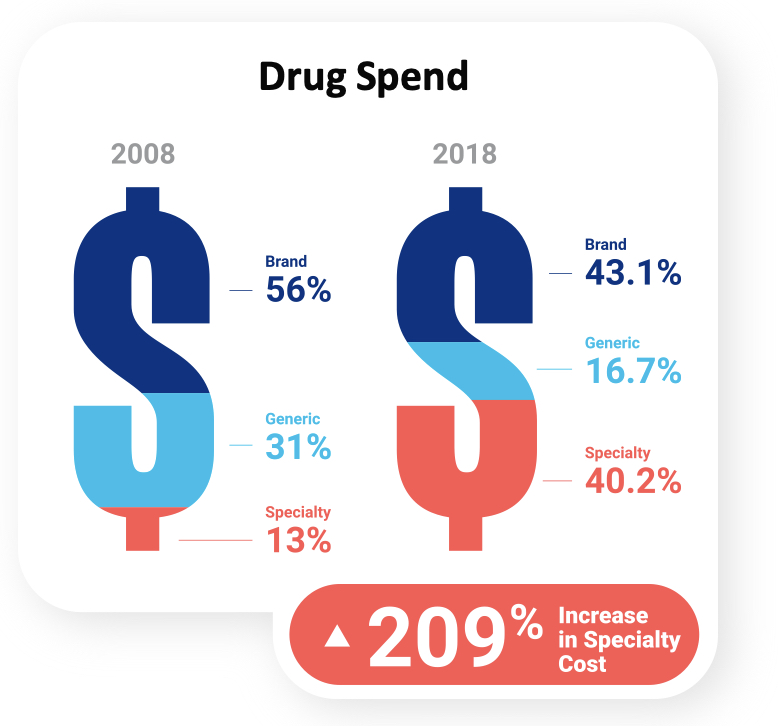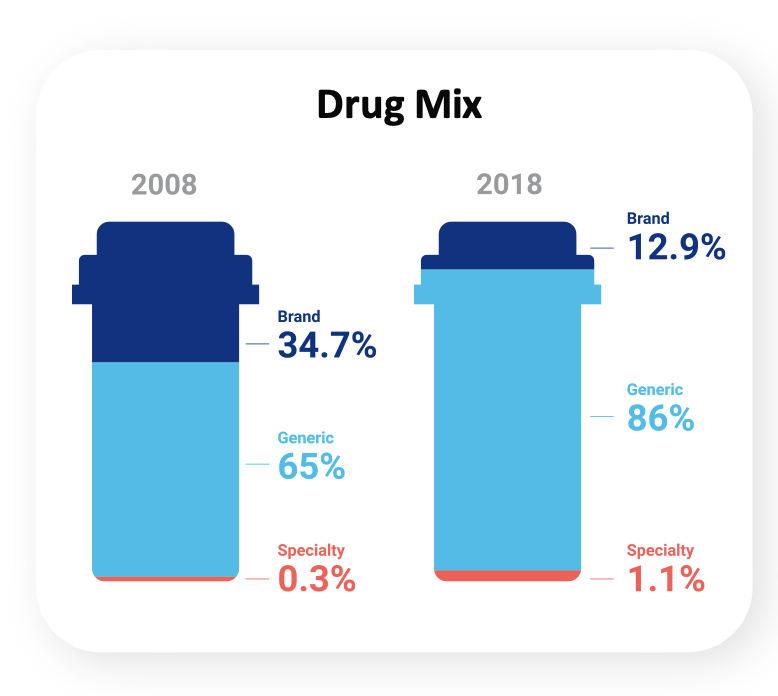By Denise Cabrera
The Centers for Medicare and Medicaid Services projects that spending for prescription drugs will be the fastest growing health care expense over the next decade, outpacing other health care spending. 90% of the nation’s $3.5 trillion dollars in annual health care expenditures are for people with chronic and mental health conditions.20 cents of every dollar spent on healthcare in the U.S. is for drug therapy. With the rise of personalized medicine and gene editing, therapy drug spend will continue to increase to over $600B this year.1
High cost specialty medications are driving an average trend increase of 2.3% with specialty drugs accounting for over 50% of total drug spend for most employers. Specialty drugs are biologics, derived from living tissue, which typically require special patient training to administer and special handling. Specialty drugs cost an average of $4,000 per month supply.1
Specialty drug utilization has remained consistent over the last 10 years however, the mix of drugs has changed significantly, as new higher cost drugs came to market and drove price increases of other drugs in the same class. An example are drugs to treat multiple sclerosis which originally cost and average of $6,000 per year until more costly drugs were approved pushing the annual cost over $73,000.
The reality for most employers is that just 1-2% of their members are driving 45-50%, or more of their plan costs. There continues to be a push to find ways to address the growing impact of specialty medications on employer healthcare costs. Despite some success with utilizing traditional formulary design and coupon programs some employers are looking at a more comprehensive approach which may require carving specialty medication coverage out to a 3rd party.


Pharmaceutical drug manufacturers have out-paced inflation with a 5% average annual price increase in 2022, which affected 742 drugs, according to a new report from the advocacy group Patients for Affordable Drugs.2 The healthcare industry continues to address challenges like reimbursement for high investment therapies and the impact of social determinants of health.
The new report shows that 11 of the 15 top-selling drugs in the U.S. incurred increases. A fourth of the drugs exceeded the most recent rate of inflation and 93% exceeded the projected inflation rate for 2023 (2.3%).2
Price hikes of blockbuster drugs2
- Pfizer raised prices on 93 drugs
6.9% on breast cancer drug Ibrance
6.9% on Prevnar vaccine
4.4% on heart disease drugs Vyndamax and Vyndaqel
- AbbVie
7.4% on Humira which already generates $22 billion in sales
- Bristol Myers Squibb
6% on Eliquis for reducing blood clots
4.5% on Revlimid for multiple myeloma
- Gilead
5.6% on HIV drugsBiktarvy and Descovy
- Purdue
5% on OxyContin
- Vertex
4.9% on Trikafta for cystic fibrosis. List price is already over $311,000 per year
10 Most Expensive Drugs3,4,5
The world’s most expensive drug, Zolgensma, entered the market in 2019 with a price tag over $2 million. This life-changing gene therapy brought hope to families dealing with a life-threatening spinal disease in their children. Luxturna, a curative gene therapy for a retinal disorder causing blindness, costs $850,000. Cigna’s Embarc program offers a shared risk network which may be adopted for $1 PMPM (per member per month) to establish full coverage of the drug and treatment for both Zolgensma and Luxterna. This program will expand as more gene therapies enter the market.
1. Zolgensma ($2,125,000)
Spinal muscular atrophy (SMA), a rare disease that causes muscular erosion. Prevalence: 1 in 10,000 live births. Novartis allows annuity payments over a five-year period and delayed reimbursement to ensure the therapy works.
2. Carbaglu ($1,598,822)
Hyperammonemia, a urea cycle disorder caused by lack of a certain liver enzyme, which elevates ammonia levels. Prevalence: 1 in 25,000 live births.
3. Procysbi ($1,085,160)
Nephropathic cystinosis, a rare hereditary metabolic disorder that causes kidney problems, slow growth, weak bones, and eye problems. Prevalence: 1 in 200,000 live births.
4. Zokinvy ($1,032,480)
Hutchinson-Gilford Progeria Syndrome, a rare disease that causes premature aging. Prevalence: 1 in 4 million live births. Most patients die before the age of 15 from heart failure or stroke.
5. Danyelza ($977,664)
Neuroblastoma bone marrow cancer. Prevalence: 10 in 1 million children under 15.
6. Myalept ($889,904)
Leptin deficiency, which causes an abnormal fat distribution in the body. Prevalence: 5 in 1 million people annually in the U.S. Aegerion Pharmaceuticals offers a copay card to assist commercially insured patients.
7. Luxturna ($850,000)
A curative gene therapy, which treats an inherited retinal disease that causes blindness. Prevalence: 4 – 10 people in 1 million lives in the U.S.
8. Folotyn ($817,865)
Peripheral t-cell lymphoma, a rare blood cancer. Prevalence: 1 in 100,000 people in the U.S. every year.
9. Amondys 45, Exondys 51, Vyondys 53 ($748,800)
Duchenne Muscular Dystrophy, a rare disease caused by over 2,000 mutations of the dystrophin gene, causing progressive loss of skeletal and cardiac function and ultimately death. Prevalence: 1 in every 3,500 live male births.
10. Brineura ($730,340)
Batten Disease, a rare pediatric brain disorder that causes seizures, loss of muscle coordination and vision loss. Prevalence: 20 children in the U.S. annually. BioMarin offers free genetic testing through Behind the Seizure.
The McGriff National Pharmacy Practice can help employers explore unique solutions which allow greater control of pharmacy spend and ensure quality clinical outcomes. Contact Denise Cabrera or your McGriff representative for further information.
Sources:
- “Projections of National Health Expenditures and Health Insurance Enrollment: Methodology and Model Specification.” 24 March 2020, https://www.cms.gov/Research-Statistics-Data-and-Systems/Statistics-Trends-and-Reports/NationalHealthExpendData/Downloads/ProjectionsMethodology.pdf
- Round 2 Of January 2022 Hikes Pushes Blockbuster Prices To New Heights | Patients For Affordable Drugs
- https://rarediseases.org/
- https://professionals.optumrx.com/publications/rx-highlights.html
- https://www.fda.gov/drugs/development-approval-process-drugs/drug-approvals-and-databases

National Pharmacy Practice Leader
McGriff Employee Benefit Solutions
Denise.Cabrera@mcgriffin.com
